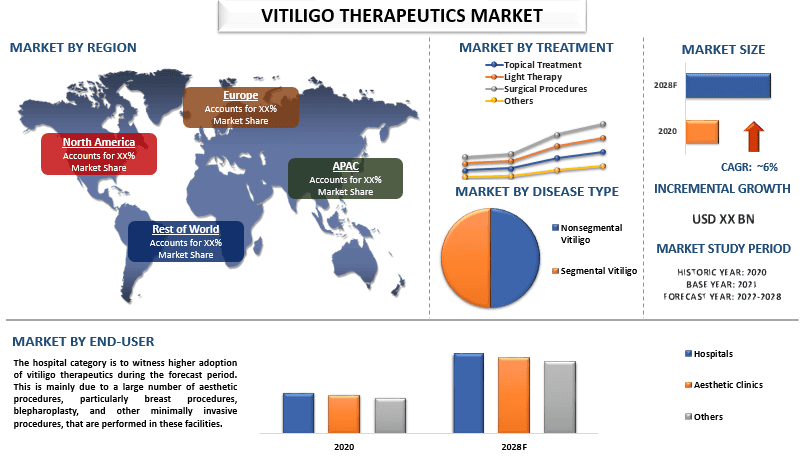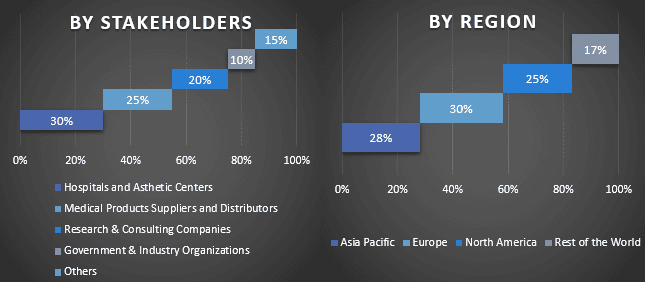- الرئيسية
- معلومات عنا
- صناعة
- الخدمات
- قراءة
- اتصل بنا
سوق علاجات البهاق: التحليل الحالي والتوقعات (2022-2028)
التركيز على العلاج (العلاج الموضعي، العلاج بالضوء، الإجراءات الجراحية، وغيرها)؛ نوع المرض (البهاق غير القطعي والبهاق القطعي)؛ المستخدم النهائي (المستشفيات وعيادات التجميل وغيرها)؛ والمنطقة/البلد

من المتوقع أن ينمو سوق علاجات البهاق العالمي بمعدل كبير يبلغ حوالي 6% خلال الفترة المتوقعة. البهاق هو مرض مزمن يتسبب في فقدان بقع من الجلد للصبغة أو اللون. يحدث هذا عندما يتم مهاجمة وتدمير خلايا الجلد الميلانينية التي تصنع الصبغة، مما يتسبب في تحول لون الجلد إلى اللون الأبيض الحليبي. العرض الرئيسي للبهاق هو فقدان اللون الطبيعي أو الصبغة، والذي يسمى إزالة التصبغ. يمكن أن تظهر البقع المصابة بنقص التصبغ في أي مكان في جسمك ويمكن أن تؤثر على الجلد واليدين والقدمين والذراعين والوجه والشعر، والتي يمكن أن تتحول إلى اللون الأبيض في المناطق التي يفقد فيها الجلد الصبغة. علاوة على ذلك، فإن زيادة الاستثمار الحكومي والتطورات الجديدة تدفع أيضًا نمو السوق خلال الفترة المتوقعة. على سبيل المثال، في عام 2019، أعلنت الجمعية الأمريكية للأمراض الجلدية (ASA) عن تمويل لأبحاث سرطان الجلد والأمراض الجلدية. إلى جانب ASA والشركات التابعة لها استثمرت أكثر من 50 مليون دولار أمريكي لعلاج الورم الميلانيني والصدفية والبهاق.
تعتبر شركات مثل Corporation و Astellas Pharma Inc. و Bausch Health Companies Inc. و Baxter International Inc. و Pfizer Inc. و STRATA Skin Sciences و Reddy’s Laboratories Ltd. و AstraZeneca AB و Eli Lilly and Company و Epizyme Inc. من بين اللاعبين الرئيسيين في السوق. وقد قام هؤلاء اللاعبون بالعديد من عمليات الاندماج والاستحواذ بالإضافة إلى الشراكات لتزويد العملاء بمنتجات/تقنيات عالية التقنية ومبتكرة.
رؤى مقدمة في التقرير
"من بين العلاجات، من المتوقع أن تشهد فئة العلاج الموضعي معدل نمو سنوي مركب قوي خلال الفترة المتوقعة" بناءً على العلاج، يتم تقسيم السوق إلى العلاج الموضعي والعلاج بالضوء والإجراءات الجراحية وغيرها. من بينها، من المتوقع أن تشهد فئة العلاج الموضعي معدل نمو سنوي مركب أعلى خلال الفترة المتوقعة بسبب الظروف البيئية المتزايدة، مثل الإجهاد أو حروق الشمس السيئة أو صدمة الجلد أو التعرض لمادة كيميائية قوية. علاوة على ذلك، يقوم كبار اللاعبين الرئيسيين بتطوير إجراءات علاج متقدمة. على سبيل المثال، في مارس 2022، أعلنت شركة STRATA Skin Sciences، وهي شركة تكنولوجيا طبية متخصصة في تطوير وتسويق وبيع المنتجات المبتكرة لعلاج أمراض المناعة الذاتية الجلدية المختلفة، أنها انضمت إلى مؤسسة البهاق العالمية كراعٍ للشركات (GVF).
"من بين أنواع الأمراض، من المتوقع أن تستحوذ البهاق غير القطعي على حصة كبيرة في السوق في عام 2020"
بناءً على نوع المرض، يتم تصنيف السوق إلى البهاق غير القطعي والبهاق القطعي. من بينها، من المتوقع أن يستحوذ البهاق غير القطعي على حصة كبيرة في السوق في عام 2020. يعتبر البهاق اضطرابًا في المناعة الذاتية. في الأشخاص المصابين بالبهاق، يبدو أن الجهاز المناعي يهاجم الخلايا الصبغية (الخلايا الميلانية) في الجلد. يمكن أن يؤدي هذا النوع من البهاق إلى فقدان سريع للون أو الصبغة ويميل إلى تغطية مساحة كبيرة. يتأثر العديد من الأشخاص المصابين بالبهاق أيضًا باضطراب واحد آخر على الأقل من اضطرابات المناعة الذاتية. على سبيل المثال، وفقًا للمعهد الوطني لعلوم الصحة البيئية (NIH)، تؤثر الأمراض على أكثر من 24 مليون شخص في الولايات المتحدة.
"من المتوقع أن تستحوذ أمريكا الشمالية على حصة كبيرة في السوق"
من أجل فهم أفضل لتبني السوق لصناعة علاجات البهاق، يتم تحليل السوق بناءً على وجوده العالمي في دول مثل أمريكا الشمالية (الولايات المتحدة وكندا وبقية أمريكا الشمالية) وأوروبا (ألمانيا والمملكة المتحدة وفرنسا وإسبانيا وإيطاليا وبقية أوروبا) وآسيا والمحيط الهادئ (الصين واليابان والهند وبقية منطقة آسيا والمحيط الهادئ) وبقية العالم. من المتوقع أن تنمو أمريكا الشمالية بمعدل نمو سنوي مركب كبير خلال الفترة المتوقعة بسبب ارتفاع حالات البهاق التي تعد العامل الرئيسي في المنطقة. على سبيل المثال، وفقًا للأكاديمية الأمريكية للأمراض الجلدية (AAD)، يؤثر البهاق على ما يقدر بواحد من كل أربعة أفراد في الولايات المتحدة. أيضًا، يقدر أن ما يقدر بنحو 1%-2% من سكان العالم يعانون من البهاق. علاوة على ذلك، البنية التحتية للرعاية الصحية الراسخة، والزيادات في المشاريع البحثية، وارتفاع معدل انتشار البهاق بين البالغين، والوعي العالي في المنطقة. أيضًا، توافر اللاعبين في السوق العالمية والتحديات التي يواجهونها بسبب المنافسة الكبيرة من العلامات التجارية المحلية والمحلية.
أسباب شراء هذا التقرير:
- تتضمن الدراسة تحليل لتقدير حجم السوق والتنبؤ به تم التحقق منه من قبل خبراء الصناعة الرئيسيين الموثوقين.
- يقدم التقرير مراجعة سريعة للأداء العام للصناعة في لمحة.
- يغطي التقرير تحليلاً متعمقًا لأقران الصناعة البارزين مع التركيز الأساسي على البيانات المالية الرئيسية للأعمال، ومجموعة المنتجات، واستراتيجيات التوسع، والتطورات الأخيرة.
- دراسة تفصيلية للمحركات والقيود والاتجاهات الرئيسية والفرص السائدة في الصناعة.
- تغطي الدراسة السوق بشكل شامل عبر قطاعات مختلفة.
- تحليل متعمق على المستوى الإقليمي للصناعة.
خيارات التخصيص:
يمكن تخصيص سوق علاجات البهاق العالمي بشكل أكبر وفقًا للمتطلبات أو أي قطاع سوق آخر. إلى جانب ذلك، تتفهم UMI أنه قد تكون لديك احتياجات عمل خاصة بك، لذا لا تتردد في التواصل معنا للحصول على تقرير يناسب متطلباتك تمامًا.
جدول المحتويات
منهجية البحث لتحليل سوق علاجات البهاق (2022-2028)
كان تحليل السوق التاريخية وتقدير السوق الحالية والتنبؤ بالسوق المستقبلية لسوق علاجات البهاق العالمية هي الخطوات الرئيسية الثلاث التي تم اتخاذها لإنشاء وتحليل اعتماد سوق علاجات البهاق في المناطق الرئيسية على مستوى العالم. تم إجراء بحث ثانوي شامل لجمع أرقام السوق التاريخية وتقدير حجم السوق الحالي. ثانيًا ، للتحقق من صحة هذه الرؤى ، تم أخذ العديد من النتائج والافتراضات في الاعتبار. علاوة على ذلك، تم إجراء مقابلات أولية شاملة أيضًا مع خبراء الصناعة عبر سلسلة القيمة لسوق علاجات البهاق العالمية. بعد افتراض أرقام السوق والتحقق من صحتها من خلال المقابلات الأولية ، استخدمنا نهجًا تصاعديًا / تنازليًا للتنبؤ بحجم السوق الكامل. بعد ذلك ، تم اعتماد طرق تقسيم السوق وتثليث البيانات لتقدير وتحليل حجم سوق القطاعات والقطاعات الفرعية للصناعة ذات الصلة. يتم شرح المنهجية التفصيلية أدناه:
تحليل حجم السوق التاريخي
الخطوة 1: دراسة متعمقة للمصادر الثانوية:
تم إجراء دراسة ثانوية تفصيلية للحصول على حجم السوق التاريخي لسوق علاجات البهاق من خلال مصادر الشركة الداخلية مثل التقارير السنوية والبيانات المالية ، وعروض الأداء ، والنشرات الصحفية ، وما إلى ذلك ، والمصادر الخارجية بما في ذلك المجلات والأخبار والمقالات والمنشورات الحكومية ومنشورات المنافسين وتقارير القطاعات وقاعدة بيانات الطرف الثالث والمنشورات الموثوقة الأخرى.
الخطوة 2: تقسيم السوق:
بعد الحصول على حجم السوق التاريخي لسوق علاجات البهاق ، أجرينا تحليلًا ثانويًا تفصيليًا لجمع رؤى السوق التاريخية وحصتها للقطاعات والقطاعات الفرعية المختلفة للمناطق الرئيسية. يتم تضمين القطاعات الرئيسية في التقرير كعلاج ونوع المرض والمستخدم النهائي. تم إجراء المزيد من التحليلات على مستوى الدولة لتقييم الاعتماد الكلي لنماذج الاختبار في تلك المنطقة.
الخطوة 3: تحليل العوامل:
بعد الحصول على حجم السوق التاريخي للقطاعات والقطاعات الفرعية المختلفة ، أجرينا تحليلًا للعوامل التفصيلية لتقدير حجم السوق الحالي لسوق علاجات البهاق. علاوة على ذلك ، أجرينا تحليلًا للعوامل باستخدام متغيرات تابعة ومستقلة مثل العلاج ونوع المرض والمستخدم النهائي لسوق علاجات البهاق. تم إجراء تحليل شامل لسيناريوهات الطلب والعرض مع مراعاة أهم الشراكات وعمليات الاندماج والاستحواذ والتوسع التجاري وإطلاق المنتجات في قطاع سوق علاجات البهاق في جميع أنحاء العالم.
تقدير حجم السوق الحالي والتنبؤ به
حجم السوق الحالي: بناءً على رؤى قابلة للتنفيذ من الخطوات الثلاث المذكورة أعلاه ، توصلنا إلى حجم السوق الحالي واللاعبين الرئيسيين في سوق علاجات البهاق العالمية وحصص السوق للقطاعات. تم تحديد جميع النسب المئوية المطلوبة وتقسيمات السوق باستخدام النهج الثانوي المذكور أعلاه وتم التحقق منها من خلال المقابلات الأولية.
التقدير والتنبؤ: لتقدير السوق والتنبؤ به ، تم تعيين أوزان لعوامل مختلفة بما في ذلك المحركات والاتجاهات والقيود والفرص المتاحة لأصحاب المصلحة. بعد تحليل هذه العوامل ، تم تطبيق تقنيات التنبؤ ذات الصلة ، أي النهج التصاعدي / التنازلي ، للوصول إلى توقعات السوق لعام 2028 للقطاعات والقطاعات الفرعية المختلفة عبر الأسواق الرئيسية على مستوى العالم. تشتمل منهجية البحث المعتمدة لتقدير حجم السوق على:
- حجم سوق الصناعة من حيث الإيرادات (بالدولار الأمريكي) ومعدل اعتماد سوق علاجات البهاق عبر الأسواق الرئيسية محليًا
- جميع النسب المئوية والتقسيمات والتقسيمات الفرعية لقطاعات السوق وقطاعاته الفرعية
- اللاعبون الرئيسيون في سوق علاجات البهاق العالمية من حيث المنتجات المعروضة. أيضًا ، استراتيجيات النمو التي يتبناها هؤلاء اللاعبون للمنافسة في السوق سريعة النمو
التحقق من صحة حجم السوق وحصته
البحث الأولي: تم إجراء مقابلات متعمقة مع قادة الرأي الرئيسيين (KOLs) بمن فيهم كبار المديرين التنفيذيين (CXO / VPs ، ورئيس المبيعات ، ورئيس التسويق ، والرئيس التشغيلي ، والرئيس الإقليمي ، والرئيس القطري ، وما إلى ذلك) عبر المناطق الرئيسية. ثم تم تلخيص نتائج البحث الأولي وإجراء تحليل إحصائي لإثبات الفرضية المذكورة. تم دمج مدخلات البحث الأولي مع النتائج الثانوية ، وبالتالي تحويل المعلومات إلى رؤى قابلة للتنفيذ.
تقسيم المشاركين الرئيسيين في مناطق مختلفة

هندسة السوق
تم استخدام تقنية تثليث البيانات لإكمال تقدير السوق الإجمالي والوصول إلى أرقام إحصائية دقيقة لكل قطاع وقطاع فرعي من سوق علاجات البهاق العالمية. تم تقسيم البيانات إلى عدة قطاعات وقطاعات فرعية بعد دراسة المعلمات والاتجاهات المختلفة في مجالات العلاج ونوع المرض والمستخدم النهائي في سوق علاجات البهاق العالمية.
الهدف الرئيسي من دراسة سوق علاجات البهاق العالمية
تم تحديد اتجاهات السوق الحالية والمستقبلية لسوق علاجات البهاق العالمية في الدراسة. يمكن للمستثمرين الحصول على رؤى استراتيجية لترسيخ تقديرهم للاستثمارات على التحليل النوعي والكمي الذي تم إجراؤه في الدراسة. حددت اتجاهات السوق الحالية والمستقبلية الجاذبية الإجمالية للسوق على المستوى الإقليمي ، مما يوفر منصة للمشارك الصناعي لاستغلال السوق غير المستغل للاستفادة من ميزة المحرك الأول. تشمل الأهداف الكمية الأخرى للدراسات ما يلي:
- تحليل حجم السوق الحالي والمتوقع لسوق علاجات البهاق من حيث القيمة (بالدولار الأمريكي). أيضًا ، قم بتحليل حجم السوق الحالي والمتوقع للقطاعات والقطاعات الفرعية المختلفة
- تشمل القطاعات في الدراسة مجالات العلاج ونوع المرض والمستخدم النهائي.
- تحديد وتحليل الإطار التنظيمي لسوق علاجات البهاق.
- تحليل سلسلة القيمة المعنية بوجود وسطاء مختلفين ، جنبًا إلى جنب مع تحليل سلوكيات العملاء والمنافسين في الصناعة.
- تحليل حجم السوق الحالي والمتوقع لسوق علاجات البهاق للمنطقة الرئيسية.
- تشمل الدول الرئيسية في المناطق التي تمت دراستها في التقرير آسيا والمحيط الهادئ وأوروبا وأمريكا الشمالية وبقية العالم.
- الملفات الشخصية للشركات في سوق علاجات البهاق واستراتيجيات النمو التي يتبناها اللاعبون في السوق للحفاظ على استمرارهم في السوق سريعة النمو
- تحليل متعمق على المستوى الإقليمي للصناعة
ذات صلة التقارير
العملاء الذين اشتروا هذا المنتج اشتروا أيضًا










